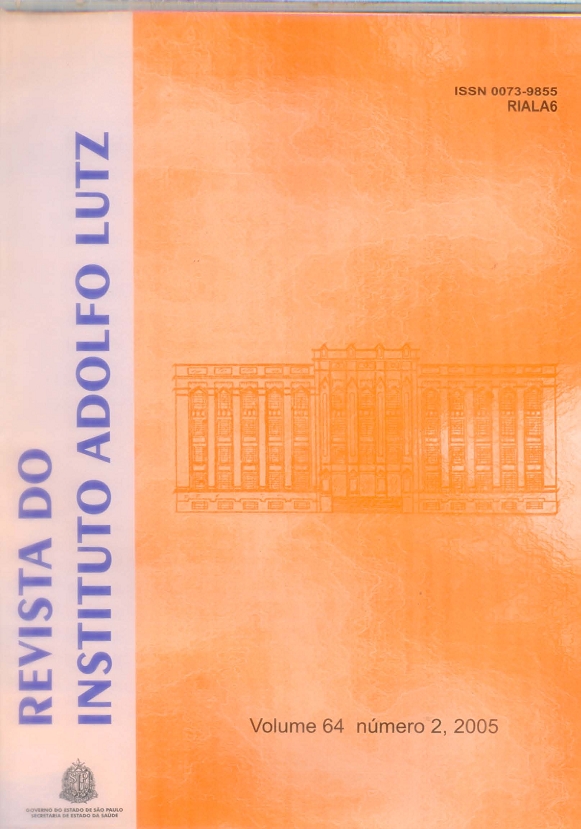Resumo
Chagas' disease is an American trypanosomiasis caused by the hemoflagellate Trypanosoma cruzi (T. cruzi). In Brazil, the control measures to eradicate the populations of native triatomine species have significantly reduced the risk of T. cruzi transmission by contaminated hematophagous insects but contamination by blood transfusion is still a serious problem, particularly in remote regions. The detection of antigen in blood sera could be useful just for the acute phase of the Chagas' disease while the detection of anti-T. cruzi antibodies in the serologic analysis is the chosen method for the etiological diagnosis of Chagas' disease in the chronic phase.The present work reports the development of an amperometric immunosensor for the diagnosis of Chagas' disease and the preliminary investigation on atomic force microscopy (AFM) by using a specific glycoprotein of the trypomastigote surface which belongs to the Tc85-11 protein family of Trypanosoma cruzi Tc85-11 was expressed as polyhistidine fusion protein using the vector pCR T7/NT TOPO® Cloning (Invitrogen) and Escherichia coli strain BL21 (DE3) plysS (Invitrogen). Tc85-11 protein was purified from inclusion bodies, solubilized in 50 mM Tris-HCl, pH 6.0, 100 mM NaCl and 1 M imidazole and purified with a Ni2+ (nitrilotriacetic acid)-column (Chelating Sepharose Fast Flow resin/Amersham-Pharmacia Biotech). Approximately 0.08 mg mL-1 of Tc85-11 protein was obtained. The presence of the recombinant protein was detected by SDS-PAGE (9% gel) and Western blot, employing anti-His tag antibodies (Amersham Pharmacia Biotech). The Tc85-11 protein was kindly donated by Walter Colli and Maria Júlia M. Alves (USP, Inst. Chem., SP, Brazil). Screen-printed electrodes (Au-2%Pd, Ag-2%Pd and Au-2%Pd as working, reference and auxiliary electrodes, respectively), were supllied by BVT Technologies, Brno, Czech Republic. The screen-printed electrodes (SPE) were modified with cysteamine and later activated with glutaraldehyde, which were used to form the covalent bond with the purified recombinant antigen (Tc85-11). The affinity reaction between immobilized antigen and antibody anti-T. cruzi (primary antibody), present in sanguineous serum of patients with Chagas' disease, was monitored by anti-IgG peroxidase conjugate (secondary antibody). This enzyme, in the presence of hydrogen peroxide and potassium iodide, catalyses the I2 formation and the reduction current intensity was measured at -400 mV vs Ag-2%Pd screen-printed electrode at 25 ºC. Electrochemical measurements were performed with a potentiostat-galvanostat (PGSTAT10 from Eco-Chemie, The Netherlands). The best results were obtained with the following conditions: dilutions of 1:20, 1:40, 1:4000 for antigen, primary antibody and secondary antibody, respectively; 1x10-4 and 3x10-4 mol L-1 for H2O2 and KI concentrations, respectively. The threshold of reactivity (cut off) was -0.158 · A. The immunosensor was applied to sera of chagasic patients and patients having different systemic diseases. Lupus erythematosus, hepatitis, HIV, schistosomiasis, paracoccidioidomicosis, rheumatic arthritis, anti-T. cruzi positive and negative sera were obtained from Diagnosis Laboratory of Faculty of Pharmaceutical Sciences (Unesp, Araraquara, SP, Brazil). Sera from hosts of systemic infections (leprosy, leishmaniasis (sp), were freely supplied by Instituto Adolf Lutz (São Paulo, SP, Brazil) and Instituto Lauro de Souza Lima (Bauru, SP, Brazil). An Extend Multimode Atomic Force Microscope controlled by a Nanoscope IIIa electronics (Digital Instruments, Santa Barbara, CA, USA) operating was used to image the electrode surface before and after the different modifications. Silicon cantilevers with a force constant of 34-65 Nm-1 and resonant frequency of 321-396 kHz were purchased from NanoWorld (Neuchatel, Switzerland). Digital Nanoscope software (v 4.22) was used to analyze the topographic images. The gold substrates used for the AFM studies were obtained depositing a gold layer either on silicon or on Si3N4 slides with a sputter system (Sputter Coater S150B, BOC Edwards, UK) followed by a thermal annealing. The atomically flat gold surface with roughness (rms) of 0.07 nm was modified with cysteamine, glutaraldehyde, and then antigen Tc85-11. In this case, no anti-IgG peroxidase conjugate was needed. Surface imaging at different levels of modification and antigen-antibody binding allow us to distinguish the affinity reactions. The specific interaction of the Tc85-11 protein with the anti-T. cruzi antibody was demonstrated by AFM resolute imaging. The studies had indicated that the Tc85-11 protein is suitable for serological diagnosis of Chagas' disease using amperometric immunosensors. However, using the immunosensor a distinguishing between Chagas' and leishmaniasis diseases was not possible yet. Future research will be focused on the interaction of Tc85-11 protein with sera of leishmaniasis by AFM.
Este trabalho está licenciado sob uma licença Creative Commons Attribution 4.0 International License.
Copyright (c) 2005 A. A. P. Ferreira
Downloads
Não há dados estatísticos.
